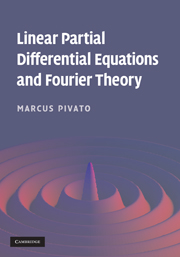Book contents
- Frontmatter
- Contents
- Preface
- What's good about this book?
- Suggested 12-week syllabus
- Part I Motivating examples and major applications
- Part II General theory
- Part III Fourier series on bounded domains
- Part IV BVP solutions via eigenfunction expansions
- Part V Miscellaneous solution methods
- Part VI Fourier transforms on unbounded domains
- Appendix A Sets and functions
- Appendix B Derivatives – notation
- Appendix C Complex numbers
- Appendix D Coordinate systems and domains
- Appendix E Vector calculus
- Appendix F Differentiation of function series
- Appendix G Differentiation of integrals
- Appendix H Taylor polynomials
- References
- Subject index
- Notation index
Part IV - BVP solutions via eigenfunction expansions
Published online by Cambridge University Press: 05 June 2012
- Frontmatter
- Contents
- Preface
- What's good about this book?
- Suggested 12-week syllabus
- Part I Motivating examples and major applications
- Part II General theory
- Part III Fourier series on bounded domains
- Part IV BVP solutions via eigenfunction expansions
- Part V Miscellaneous solution methods
- Part VI Fourier transforms on unbounded domains
- Appendix A Sets and functions
- Appendix B Derivatives – notation
- Appendix C Complex numbers
- Appendix D Coordinate systems and domains
- Appendix E Vector calculus
- Appendix F Differentiation of function series
- Appendix G Differentiation of integrals
- Appendix H Taylor polynomials
- References
- Subject index
- Notation index
Summary
A powerful and general method for solving linear PDEs is to represent the solutions using eigenfunction expansions. Rather than first deploying this idea in full abstract generality, we will start by illustrating it in a variety of special cases. We will gradually escalate the level of abstraction, so that the general theory is almost obvious when it is finally stated explicitly.
The orthogonal trigonometric functions Sn and Cn in a Fourier series are eigenfunctions of the Laplacian operator Δ. Furthermore, the eigenfunctions Sn and Cn are particularly ‘well adapted’ to domains like the interval [0, π], the square [0, π]2, or the cube [0, π]3, for two reasons:
the functions Sn and Cn and the domain [0, π]k are easily expressed in a Cartesian coordinate system;
the functions Sn and Cn satisfy desirable boundary conditions (e.g. homogeneous Dirichlet/Neumann) on the boundaries of the domain [0, π]k.
Thus, we can use Sn and Cn as ‘building blocks’ to construct a solution to a given partial differential equation – a solution which also satisfies specified initial conditions and/or boundary conditions on [0, π]k. In particular, we will use Fourier sine series to obtain homogeneous Dirichlet boundary conditions (by Theorems 7A.1(d), 9A.3(d), and 9B.1(d)), and Fourier cosine series to obtain homogeneous Neumann boundary conditions (by Theorems 7A.4(d), 9A.3(e), and 9B.1(e)). This basic strategy underlies all the solution methods developed in Chapters 11–13.
- Type
- Chapter
- Information
- Linear Partial Differential Equations and Fourier Theory , pp. 227 - 228Publisher: Cambridge University PressPrint publication year: 2010



